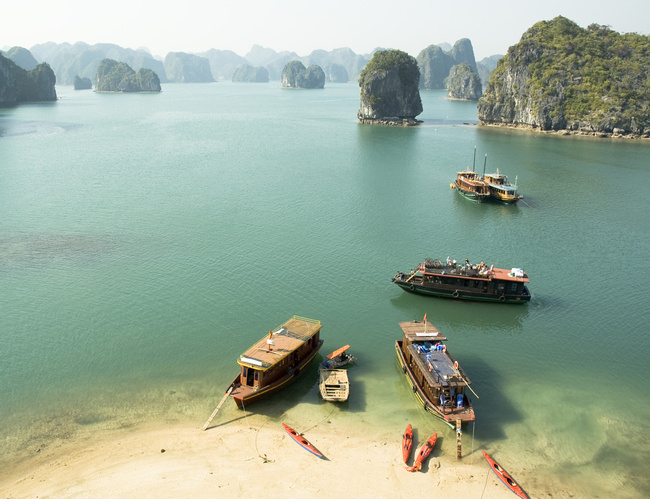- Travel Guides
Holidays and Festivals in Vietnam
Vietnamese festivals follow the lunar calendar. In the lunar calendar, the month follows the phases of the moon and always begins with the new moon. Festivals are usually specific to a given town. New Years is the largest countrywide celebration, and much of the country shuts down during this time of year.

Lantern Festival in Hoi An — 14th Day of the Lunar Month
These festivals tend to be packed, and carry on until 8 or 9 pm. As you wander through the stalls, stop to try some moon cake. Moon cakes are rich, dense, confections with notes of coconut and peanut butter. Each cake has a cooked yellow yoke in the center that represents the moon — you can see the perfect yellow sphere when you cut the moon cake in half.
During the Full Moon Festival all the shops in old town turn off their electric lights, so you can better appreciate the glowing orbs that crowd the street. Visitors can light lanterns and set them adrift on the river. It’s a magical sight, and most would agree it’s worth the crowds.
Vietnamese New Year
The Vietnamese New Year, or “Tet,” is the largest celebration in Vietnam. This new year’s celebration happens a little bit later in the year than it does in Western countries, typically sometime in February. Tet celebrations last for about a month.
The New Year is typically the one time of year when Vietnamese people get to take a vacation, so streets in many cities are often deserted and fewer shops remain open. This time of year also has less-than-ideal weather in Hanoi (and the rest of northern Vietnam). Celebrations vary depending on where you are — for instance, if you find yourself in Hanoi during the New Year, you can see the Water Puppet Festival at Thay Pagoda.
In preparation for Tet, Vietnamese families clean their homes. Cleaning is supposed to help get rid of any bad vibes. Much like Christmas in the West, Tet is a time when people put on their best behavior — a little extra niceness is supposed to set a good tone for the rest of the year.
Perfume Pagoda Pilgrimage — February/ March
During certain times of year, religious sites see an especially high influx of visitors. Perfume Pagoda pilgrimages takes place in the first week of the lunar calendar. This pagoda is carved into the porous limestone of the Huong Tich Mountain range. In order to reach this obscure corner of the globe, visitors need a boat as well as a guide. Vietnamese visitors typically visit this holy site in the couple of months immediately following the lunar New Year, which means the site gets busy around February and March.
Thanh Minh — Springtime
During the Thanh Minh festival, Vietnamese people clean the graves of their ancestors. This takes place during the third lunar month, which falls sometime in early spring. Families in rural areas often have graves on their property, on the edge of their rice paddy. Thanh Minh is also known as the “cold food festival,” and celebrants partake of food they can make without a fire. According to tradition, this practice dates back to the fiery death of an ancient king’s advisor.
Liberation Day/ Reunification Day — April 30
April 30 marks the end of the Vietnam War, when the People's Army of Vietnam and the National Liberation Front of South Vietnam seized control of Saigon. They went on to rename the capital Ho Chi Minh City. While it’s known as Liberation Day in Vietnam, American history books recall it as “The Fall of Saigon.”
This is a patriotic holiday, and you’ll see a sea of red flags everywhere you look. Vietnamese Liberation Day celebrations are similar to Independence Day celebrations in the United States — parades with floats and performances crowd the streets.
Worker’s Day — May 1
Every Communist country places heavy significance on May 1. This is the official holiday for workers. According to Communist ideology, ordinary laborers are the force around which society revolves.
Ghost Month — August / September
During the seventh month of the lunar year, Vietnamese strive to placate wandering spirits with money. Don’t pick up smaller bills that you see lying in the street at this time of year — those are for the ghosts, and woe unto the traveler that takes a ghost’s pocket money. (Superstitions might not be your cup of tea, but why not err on the side of caution?)
Independence Day — September 2
On September 2, 1945, Vietnam declared itself independent from France. This was the beginning of the rise of Communism in Vietnam. Fireworks light up the sky and public festivities take over municipal spaces.
Trung Thu — Mid-Autumn
Trung Thu takes place on a night with a full moon, and is marked by munching on moon cakes and lighting colorful lanterns. Families and friends gather for special meals, much like Thanksgiving in the U.S. Traditionally, this holiday took place at the end of the harvest.
Flower festival — December (Biannual)
Vietnam’s steamy climate allows for some incredible blossoms. Da Lat is known for its profusions of colorful flowers, and local horticulturalists arrange them in elaborate displays. The flower festival takes place in December during odd-numbered years.
Christmas — December 25
There are some Christians (mostly Catholics) in Vietnam, and they are the only Vietnamese to observe a traditional Christmas. That being said, the commercial side of Christmas has started to catch on, and Vietnamese children have begun to look forward to visits from Santa Claus.
It's more than just having a good time or visiting beautiful places (although that's absolutely a part of it!), it's about being part of a unique experience that stays with you.



